Spring has finally arrived! Our phenomenally appalling weather for almost all of March has thankfully moved on. Last week we had mudslides and fallen trees everywhere, but this week the sun is shining, and we’ve been enjoying some glorious spring weather. With the first warm spring days, also come the first spring honeybee swarms!
Our neighbors called us Wednesday to say there was a swarm in their plum tree. Former beekeepers themselves, they don’t currently keep bees, but have had feral bees in their attic for a number of years. Each spring they see a swarm or two in their garden. I’d enquired a couple of months ago to see if they would be willing to let us know the next time they saw a swarm in their garden.
Although we have two packages of bees on order, feral bees, wild bee colonies that have survived winter without any human intervention, no medications, and no supplemental feeding, are considered to be composed of far superior genetic stock than any bee you can obtain in a package from a commercial apiary.
Feral bees aren’t a guarantee of a healthy colony, but they certainly increase the likelihood of more robust, healthier bees. As such, with all of the modern day maladies affecting bees, many small-scale beekeepers would much rather start their hives with wild bees than commercial bees in their apiaries.
We weren’t sure what the likelihood would be of obtaining a feral swarm this year, so we went ahead with our package order, but those bees aren’t expected to arrive for a couple more weeks yet.
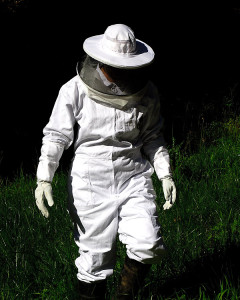
I prefer to wear a full bee suit, veil and gloves. Mr. Curbstone just wears a bee jacket and veil. It's about what you're comfortable wearing around bees.
Curious to see where our neighbor’s swarm was, and whether or not we’d even be able to reach it, I grabbed my bee suit, a box, a spray bottle, bee brush, and a roll of tape, and set off for the neighbor’s yard.
When I arrived I saw a very tall pruning ladder perfectly positioned under a mature plum tree, and just above the ladder, a rather large swarm of bees hanging from the tangle of branches within.
Our neighbor’s weren’t home, and Mr. Curbstone wasn’t home either. I’m not fond of tall ladders, especially up past the 5th or 6th rung. That’s why Mr. Curbstone climbed the extension ladder when we installed our owl box recently. Even if I could muster the courage to climb it, it didn’t seem sensible to climb one that tall without someone else around.
Disappointed that the swarm seemed out of reach, and with no one to help, I set the box down and un-suited, and watched the bees for a few minutes. The only option available to me at that moment was to maybe try setting up our empty Nuc hive nearby, and dropping a pheromone lure in. I didn’t expect it to work, but figured it couldn’t hurt to try. The trouble is a swarm can take up to four days to choose a new nest site [1], and our surrounding woodland probably has much nicer hollow tree cavities for nesting in.
After setting up the Nuc, I headed home. About 5:30 PM I wandered back over to see if the bees were still there, and they were. There was shade across the tree now, and the bees seemed to be clustering a little tighter together. I chatted with one of our neighbors for a bit, while watching the bees, and after a while it seemed clear these bees weren’t going anywhere that night. Our neighbors willingly gave me permission to come back early the next morning to see if Mr. Curbstone might be able to retrieve the swarm.
Early the next morning, with Mr. Curbstone in tow, we grabbed our trusty box, our bee suits, and the rest of our gear, and headed back over to the swarm tree. The bees looked very cold, and were clustered very tightly together. The sun was up, but it was only 47 degrees outside. We inadvertently flushed a covey of California Quail as we walked down the driveway, and they flew up into the plum tree, knocking into the bees.
I could see a small blob of bees drop down to the ground into the damp grass, but once the quail flew off it seemed the vast majority of the colony was still intact.
The tree the bees had chosen was an old plum tree that hadn’t been pruned in some time, with lots of smaller tangled branches all around the bees. The bees themselves were stretched across a broad crotch on a sizeable limb, but underneath them it was going to be very difficult to negotiate a box to catch them in.
Our fearless neighbor, eager to help, offered to help prune some of the offending smaller branches out of the way.
After some light pruning, next we sent Mr. Curbstone, box and bee brush in hand, up the ladder.
I should mention that up to this point, we had no bees of our own, and that neither of us has ever caught a swarm before, nor been out with anyone else catching a swarm. We did go to a swarm catching lecture a couple of months ago, but that was all theoretical discussion, not practical experience. I’m not sure if we’re just brave, or completely crazy!
We were aware that bees in a swarm are generally very calm. Although they have their Queen with them, they have no structure to defend. As there was still a damp chill in the air that morning, the bees really weren’t moving much, or very bothered by the man in the bee-suit now eye level with them at the top of the ladder.
After some wiggling around in the tree trying to situate the box under the bees, we realized just how large the swarm was. It was wider than the box, so some periodic readjustments had to be made to ensure we didn’t lose any more clusters of bees on the ground.
As there was no way to know where in the cluster of bees the Queen might be, to be safe, we had spread out a large sheet under the tree to catch any more chilled blobs of bees that might fall. Fortunately though most of the swarm was quite quickly gathered into the box.
With the box now full of bees, and getting quite heavy and awkward to maneuver, Mr. Curbstone brought the box down the ladder, and we quickly covered 95% of the box with a manipulation cloth, leaving a corner slightly open so any stray bees could find the rest of the colony.
In the meantime, Mr. Curbstone took a second narrower box up the ladder to see if he could retrieve some of the bees still clustering further up the branch. He brought the second box down, and we combined those bees into the larger box.
We then left the bees alone for a while to give the straggler bees a chance to make their way toward the box as the temperatures warmed. In the meantime we came home and set up the hive so it was ready for the bees when they arrived.
We set up one of our new hives for the bees, and mixed up some 1:1 sugar syrup as food. The bees had swarmed more than 24 hours previously, and been caught outside in the cold overnight, so a little boost with some supplemental food until they’re settled in seemed prudent.

This hive was assembled and painted in anticipation of the arrival of our package bees, but the swarm needed a home
Once the hive was in position, it was time to go back and retrieve our box of bees. There were a few girls still hanging on the edge of the box, but we closed it up, hopped in the truck, but kept our suits on as we only had to go a very short distance. Yes, there were a few bees buzzing around inside my truck, but they were amazingly calm, docile bees, and they weren’t buzzing around too much.
Once we were home, we set the box in the shade as the sun was warming up the hillside where the bees would be hived quite quickly. We left them for about a half hour until everyone settled down. It’s amazing to listen to the roar inside a box of excited bees when they’re being moved, and then a few minutes later all you can hear is the quiet contented hum from the bees as they relax.
Now it was time for the important part. Getting the bees into the hive. The first hive body was full of frames, including some frames of drawn comb that one of our beekeeping mentors had given us. There can be risks to using comb from a different hive, but there are benefits too. His hives are mostly feral colonies, and he doesn’t use medications in his hives, so we considered this to be premium comb. Hiving a swarm without some drawn comb is more likely to fail, but drawn comb is enticing to bees, especially as they become desperate to find a new home when they’ve swarmed. A little drawn comb means the bees can quickly begin storing food, and the Queen has a place to lay eggs sooner than if she had to wait for the colony to make new comb from scratch.
On top of the hive body with the frames, we placed an empty hive body to help serve as a funnel as we add the bees to the box. Just so a large ball of bees didn’t slop over the edge and land on the ground. If we don’t get the bees in the hive with their Queen, it’s game over.
Once we dumped the bees in, we quickly draped the hive with the manipulation cloth, and left them alone for a few minutes. There were still some bees in the box, and soon it seemed that a number of the bees were trying to return to the box.
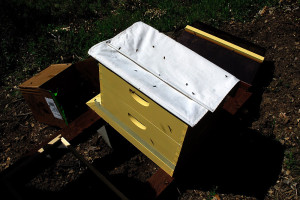
The manipulation cloth allowed us to temporarily cover the hive without squashing any bees. This cloth is designed for beekeeping, but a dish towel would work for this purpose too
Concerned we may have accidentally left the Queen in the box, we pulled back the cloth, and dumped as many of the remaining cluster of bees in. We then just set the box by the entrance to the hive so the few stragglers could find their new home.
This time everyone seemed much happier, and the bees were transferring from the box to the hive, not the other way around.
As this was a substantial swarm, and we’re using medium 8-frame hive bodies, we went ahead and carefully slid the frames into the upper hive body. We left an empty medium over the inner cover, as the hive stand is not yet ant-proof, and if needed we can quickly shift to offering feed inside the empty hive body instead of at the entrance to the hive.
The empty medium was removed this morning. Except for feeding, now we’ll leave them alone for a few days. If when we open the hive after they’ve settled in it seems as if there’s too much room, we may remove the upper box, but we’ll see how many frames the bees are covering once they’ve settled down. We have no idea yet if we managed to safely transfer the Queen. We’ll have to wait and see what we find during our first hive inspection.
Depending on who you ask, the general consensus is that hiving a swarm fails approximately 20% of the time. Once the Queen begins laying eggs though, the bees will be invested in the hive. The next few days will be critical. If for any reason they don’t like their new home, they’ll simply leave for greener pastures. We know it can, and does happen, but we’re hoping they’ll stay.
So we’ve graduated from wanna-bees, to new-bee beekeepers, and couldn’t bee happier! So far this morning it’s looking promising. We even caught a bee returning to the hive with pollen.

When we checked on food reserves this morning we noticed plenty of activity at the entrance, and a bee returning with pollen (black arrow - click to enlarge image)
We’ll let you know what we find after our first inspection of this hive in a few days. Now though, we need to hurry out and buy some more hive equipment before our packages arrive, as we’re now one hive short!
————-
[1] Seeley, Thomas D., Honeybee Democracy. 2010. Princeton University Press

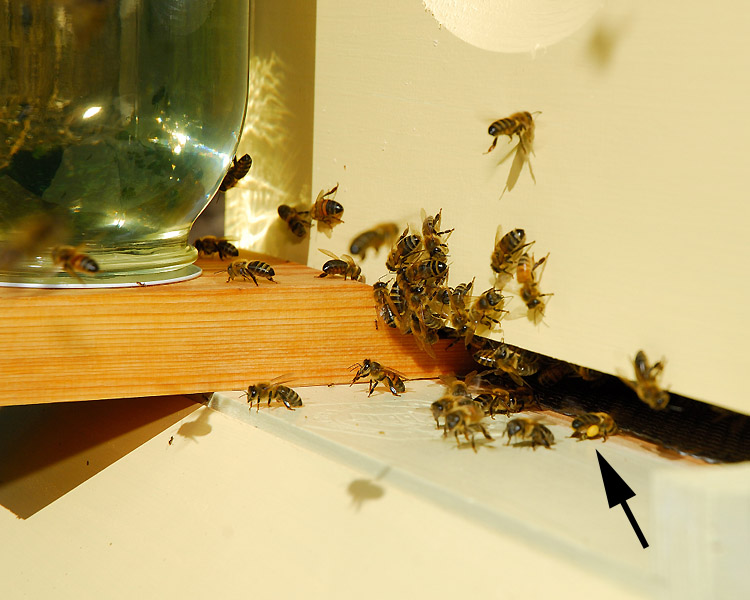
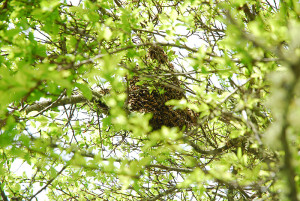
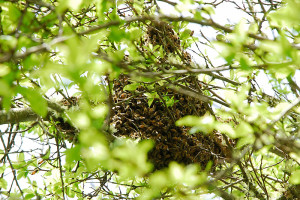
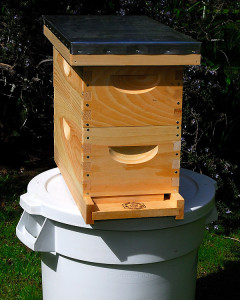
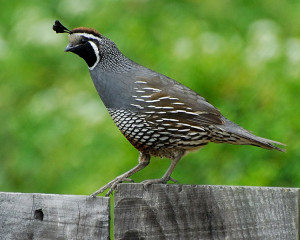

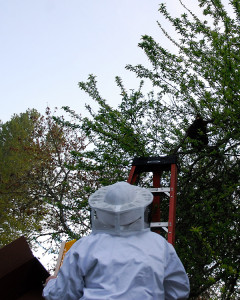
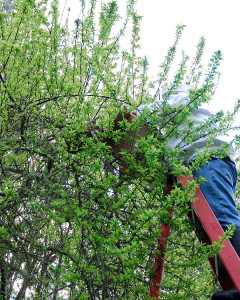

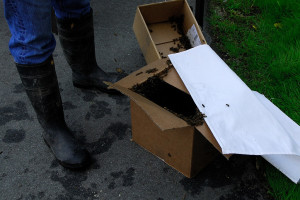
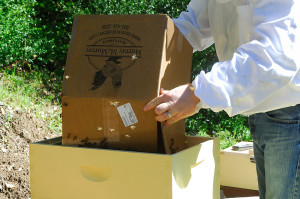
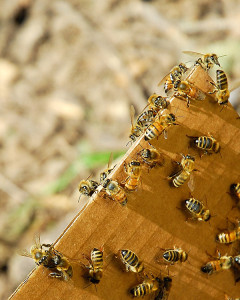
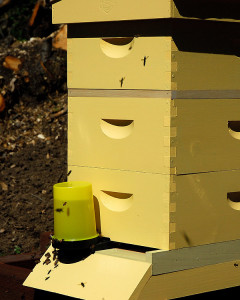








How exciting… fingers crossed you’re soon posting a picture of the queen.
I hope so too. Although even if we can’t find the Queen, if we see eggs in the brood cells, we’ll know she’s in there somewhere. They’re not always easy to spot!
I hope you’ve caught the queen! What an exciting story – good thing you were so close to being ready for your ordered bees to arrive so you could take advantage of a wild swarm!
The timing really was perfect. Our weather has been so bad I only just recently got this hive all painted up! I’m starting to think it might be a good idea to keep an extra lid and bottom board on hand…just in case lightening strikes twice 😉
You are the bravest and most adventurous folks I know. Talk about “jumping in the middle of the lake and learning to swim” – I am so impressed! Best wishes for the firm establishment of your bee hive. This is so cool…
If you told me a year ago that I would go out, without any experience, and pick up a feral swarm for my first bee colony, I’d have laughed. Certainly didn’t plan it, but so glad it happened. Also glad we’ve been doing our homework in advance too, so at least we had an idea what to expect, and an understanding of the mechanics of hiving a swarm. We’re probably still crazy though 😛
Another fabulous adventure at Curbstone Valley…and write the stories so perfectly Clare!
Looking forward to the next chapter….great post!
Thanks Susan! Looking forward to writing it…just crossing my fingers it’s all good news!
We once briefly had a swarm of wild bees in our living room, at the Camps Bay house. Waited quietly and patiently and they moved on out.
That’s the wonderful thing about swarms. They’re just calmly waiting it out until the scout bees decide on the best place to live. It doesn’t take long, and eventually they move on. Glad they didn’t try to take up permanent residence inside your house though. I often wonder what the inside of our neighbor’s attic looks like!
Let’s bee hopeful you have the queen!
I was so wrong with my guess! I thought you had some young turkeys in your yard!
That’s amazing! Where did you get your space suit? 🙂
Haha, you would expect we’d have had more fowl on the farm…especially as it is Fowl Friday. The bees usurped the chickens this Friday though. This was too much fun not to share! 😉
Wow, talk about “be careful for what you wish for, because you just might get it!”
Isn’t swarm catching thrilling? I noticed that you had your gloves off while transferring bees. Swarm bees really are docile.
I’m so impressed with how this played out. Now, resist the urge to peep as long as you can!
It’s so rare that wishes seemed to get granted! We didn’t get stung once. These bees were just so placid. If they stay, I’ll be interested to see how they are to work in a few months though once the hive is well established. This whole thing does feel a lot like great beginners luck so far. It is difficult resisting the urge to peek, but it’s in their best interests to be left alone for a bit. We are looking forward to that first quick inspection though!
Great post, and extremely informative! I’ve always thought that beekeeping might be in my future, and it’s nice to read about somebody “just starting out”. I’ll be following along eagerly!
Thanks for stopping by Alan. I hope we can help inspire you to get some bees too! 🙂
Sounds like you all have really jumped in feet first! I’m hoping the swarm takes off in their new home.
I’ve decided to get back into beekeeping and order a hive. I’ll be going with a package of bees.
Also, we made that butternut ravioli last week and it was dee-vine!
So excited to hear you’re getting bees again! With as much produce as you grow, it makes so much sense to have a little pollination crew in the garden too.
Thrilled you tried the ravioli, and liked it! I could eat that for dinner often. Next fall I’m going to have to make and freeze more! 😉
Pretty cool and just getting started! Glad so far everything went as ‘planned’. Hope the swarm sticks. Seems like enough bees for 3 brood boxes. I get my bees in a month!!
You might be right about 3 brood boxes. We’ll update on our first hive inspection on Monday…there’s a LOT of bees!
How exciting! I’m just imaging climbing a ladder and trying to get a swarm of bees in a box… don’t think I could do it. I hope the bees make their home in the box. It’s going to be fun to watch the process.
How exciting! I hope your new bee’s figure out how good their going to have it at Curbstone Valley! 🙂
Another fabulous chapter in the bee adventure. Every picture was absorbing, and the one where the bees are peeking out of the box gives them a major cuteness factor This kind of happiness just is the best. I’ll be watching to see what happens.
Hi Clare – that’s fantastic news – what an exciting way to get a bee colony! You’re spot on about the Queen being hard to see, Mr Gippy calls me over sometimes when he’s doing his regular inspection of the hive and has tried to point out the Queen to me, but I never seem to see her!
It is has become our late afternoon pastime to watch the bees fly home with laden pollen-bags, I never seem to tire of it!
I would be interested to learn more about the challenges facing bees and beekeepers in the US, as Australian colonies are still largely free of the major diseases faced in other countries.
The biggest problem we have is the Varroa mite. We’ll definitely be doing some posts on the common threats to our honeybee populations.
Congratulations on your new additions. I hope they stick around, but why wouldn’t they… they have such a bee-utiful new home!
I love following your beekeeping exploits. Good thing you had all your bee gear ready!
I can just picture your husband talking gently to the bees…
“Now, don’t be bothered by the man in the bee-suit..there’s nothing to see here…”
That whole post had me laughing, even though I’m sure that wasn’t your intention. Your mailman must either dread coming to your house, or he sees it as an adventure. Live chicks one week. Feral bees the next. I’m intrigued to know what else you have on order!
Your life is so awesome 😀
We’re sparing the mail man when our other bees arrive. We’ll actually pick them up, rather than have them mailed 😉
What an exciting turn of events and a story to tell everyone… let’s see, you just did that. 😉 Clare, I can’t wait to hear the result. My guess is that she is there.
I couldn’t wait to get to the end of this hair-raising story and find out what happened—absolutely thrilling. Please let us know if they stayed in their new home.
What a fascinating post!! There are bee keepers near my home whose bees feast in my garden but I’ve never heard of catching a feral swarm. It’s amazing how cooperative the whole process was. I hope the hive is a huge success.
Clare, how exciting! I’ve read about swarming bees before but I’ve never seen it myself. Your pictures were great. Amazing how you can just scoop them into a box and they are so cooperative. Best of luck, I hope they like their new home.
I really enjoyed reading this post. I hope your bees and their queen are happy in their new home. I admire Mr. Curbstone’s bravery in acquiring the swarm. He deserves all the honey he gets!
Facinating post Clare – I sat on the edge of my seat as I read this. I can’t wait for your next installment I’m loving this topic.
Your neighbour was brave to go up there and prune those branches – I presume he had protective gear on aswell?
Actually no, he ran up the ladder in jeans and a t-shirt. Our neighbor kept bees many years ago, and is very fearless. I think secretly he was probably laughing at me in my full bee-suit and veil! 😛
Clare, Thank you for sharing your exciting bee story! I loved it…I’ve never run across a swarm and imagine it can be both exciting and scary! I hope they settle in and you and Mr Curbstone have great success as bee-keepers. gail
How exciting! I’ve been desperate for bees for some time now, but can’t figure out where to put them.
Oh Dear. Clare, I write this with trepidation, as this post greatly saddens me. I have wild honeybees on my land and they have lived here for many years. I feel so sad that even when you say “and our surrounding woodland probably has much nicer hollow tree cavities for nesting in.” you still chose to capture the wild bees. I have so much respect and admiration for you Clare, for the way you live your life and the loving care you provide for your farm animals.
I am sorry to have to say that I feel very concerned for the bees. Wild bees should be respected just as other wild creatures. I know they were not always wild but that was long ago and they have naturalized here.
Maybe there is something I am missing and certainly I am open to trying to understand the good in what you have done. I surely understand from a beekeepers point of view that wild bees are stronger and better in creating a healthy controlled hive. I just feel we should let the wild ones be free.
Interesting post in any case. Yes, I do buy honey so you might think me being a hypocrite here. I believe the supply for domestic bees is doing well and you say you have some on the way. I sincerely hope you will not mind my being honest with you about my feelings. I have written and shared our wild bees in a few posts . . . part of the wonder to me is that they are wild and choose to live here. I would never dream of letting anyone capture them and while doing so possibly put them in harms way. I am sure you did a lot of research and will do your best to care for these bees. I look forward to following their story.
Carol, I understand your concern, I truly do. We’ve been doing an enormous amount of homework and preparation in recent months.
In case there’s any confusion, these are feral European honey bees, not wild bees, as in they’re not a wild bee species. At some point the progenitors of this population escaped from someone’s hive. That could have been recently or many years ago. Most swarms in this area are from other people’s hives.
The reasoning for hiving this swarm was two fold. To protect this group of bees, and to encourage the production of new Queens from this healthy population.
When I mentioned the trees, I meant in regard to them even looking at the smaller Nuc box I set out that afternoon, and said that somewhat tongue-in-cheek. The hive they are in now is huge in comparison.
There are a number of methods and approaches in beekeeping that I don’t like, and that I feel have contributed to the bee’s plight today, and I hope to avoid them.
The first, and most important reason for hiving this swarm, is that European honeybees are in massive decline, globally, and the situation is not improving as much as it should be. Beekeepers in this area lose 30-70% of their hives every year. This last winter, most beekeepers we spoke with lost 50-100%. There are many reasons for this but the core of the problem, in my opinion, is that the genetics are weak because commercial honeybee production involves using chemicals and artificial feeds to keep bees in colonies that otherwise would be selected against for being weak. Honestly, by purchasing package bees I feel much more irresponsible than I do hiving this swarm. Buying bees perpetuates the breeding and production of weak colonies. Beekeepers created some of the mess the bees are in now, and beekeepers share the responsibility for trying to fix it.
Small scale beekeepers who are working to build populations from feral swarms seem to be finding their bees are more resistant to the pests and diseases that so commonly affect ‘package bees’, and are better able to survive through the winter.
The parent hive from this swarm is still in my neighbors attic, and it will stay there. They are gracious enough to share their home with the bees, and enjoy them being there. There’s still a huge amount of activity there. These bees from the swarm constitute only a portion of that original colony. Swarming is a natural part of a honeybee life cycle, a new Queen is made, the old Queen must leave. If she stays, she’ll be killed, but leaving also has considerable risk for the Queen and workers that leave the hive. Especially when the weather is erratic, as it has been here.
If the the bees do not find a suitable home quickly, the entire swarm, including the Queen, can perish. By providing them with a home quickly, we actually can help ensure that the Queen can continue produce young so these stronger bees can be sustained, and produce many new generations here. Our goal is to help these bees produce many new colonies of strong bees, and remain as healthy as possible.
I assure you there’s no malice of intent here, least of all toward the bees. I have enormous respect for bees. All bees. The only selfish part is that I’m hoping they’ll help with pollination here. I don’t even expect honey, that’s not my purpose. I’d rather the bees kept their honey if they need it to help keep them strong. All we’re doing is providing a home, and my job is to ensure they have everything they need to thrive and be healthy. They’re free to wander through these same woods where they’ve been before, and trust me, if they don’t like their new house, they will leave. They’ll only stay if the hive suits them. Ultimately, the bees know what works best for them.
Dear Clare, You have more than address my concerns. I know the bees were not wild originally. I have even read that they are competing with native wild bees. As I mentioned I have had a healthy hive here for years living wild in one of my Rock Maples. I am sure you will care for your bees and everything you say makes so much sense. I too was upset with beekeepers, for what I believed to be the decline in the honeybees. Colony collapse seems to me to be caused by just the things you mention. I think it great that you will allow them to keep most of their honey. I know they must fine a new home or the entire hive will die and if anything happened to the Queen they would all die. I have seen many swarms here and realize that your hive will produce a new Queen who will create a new colony. You can see my posts on Honeybees in my labels at the bottom of my blog. (like you really have time for such things.) I see that you have a completely different approach to beekeeping and I should have guessed so with your thoughtful, animal husbandry practices. Thank you for sharing so much with me. Best of luck with your new residents.